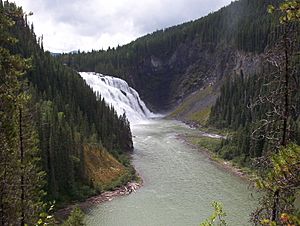Alexander Monkman facts for kids
Alexander Monkman (born March 29, 1870 – died September 26, 1941) was a Canadian Métis pioneer. He was a trader and a leader for farmers. He lived in the Lake Saskatoon area of Alberta. Monkman found a special route through the mountains called Monkman Pass. He also worked hard to build a highway through this pass in the 1930s.
Early Life
Alexander Monkman was born on March 29, 1870. His birthplace was Manitoba House. He grew up near Fort Garry. After the Red River Rebellion, his family moved to Edmonton. He went to mission schools there.
Later, Monkman traveled to Montana. He became a rodeo rider for a time. In 1898, he returned to Edmonton. From there, he tried to travel overland to join the Klondike Gold Rush. But he realized his group would not make it. He was the only one to turn back. He never heard from his companions again.
A Pioneer Trader
Monkman was hired by William Bredin and James Cornwall. He became the manager of a new trading post. This post was near Lake Saskatoon in the Grande Prairie area. He lived there with his wife, Louisa.
He was the first trader in the region who was not part of the Hudson's Bay Company. He was very successful. He managed to get many furs that the Hudson's Bay Company usually traded. This area was a meeting spot for Dane-zaa and Cree Indigenous peoples. They would set up summer camps there. Soon, a small village grew around the trading post. It had churches, a bank, and a post office. The settlement at Lake Saskatoon was later moved to Wembley in 1924.
By the early 1900s, Monkman owned land near Flying Shot Lake. He also received help from the government. The government wanted to help farming grow in the area. They gave free seeds to settlers.
Discovering Monkman Pass
In 1922, Monkman was looking for a mineral called tungsten. He was exploring in the Rocky Mountains. During his search, he found a new pass through the mountains. This pass was later named after him. It became known as Monkman Pass.
Farmers in his region needed a way to ship their grain. They wanted to send it cheaply to the seaport in Vancouver. At that time, grain traveled by train. The route went through Peace River, Edmonton, and Calgary. This was a very long trip, about 1700 miles. Monkman's route would cut off 1000 miles from that distance. Engineers even said Monkman's pass was easier to cross than the Yellowhead Pass. The Yellowhead Pass is near Jasper. However, the Yellowhead Pass was chosen for the main transport line through the mountains.
Building a Highway
By 1936, shipping costs were very high for farmers. Monkman suggested that farmers build a highway themselves. This highway would go through the Monkman Pass. It would help lower their shipping costs. People started raising money for the project. Signs for the 'M.P.H.' (Monkman Pass Highway) were put up everywhere. Construction began with volunteers. They started from Rio Grande.
By 1937, the volunteers had built a rough road. It went past the Alberta-British Columbia border. They even reached the Kinuseo Falls. A fishing resort was started there. However, the Second World War began. This brought an end to Monkman's highway project.
Legacy
Alexander Monkman died on September 26, 1941. He passed away back in Grande Prairie. His name lives on in British Columbia. There is a Monkman Provincial Park. There are also Monkman Falls. A book called "People of the Pass" tells the story of the struggle to build a road through the pass.


